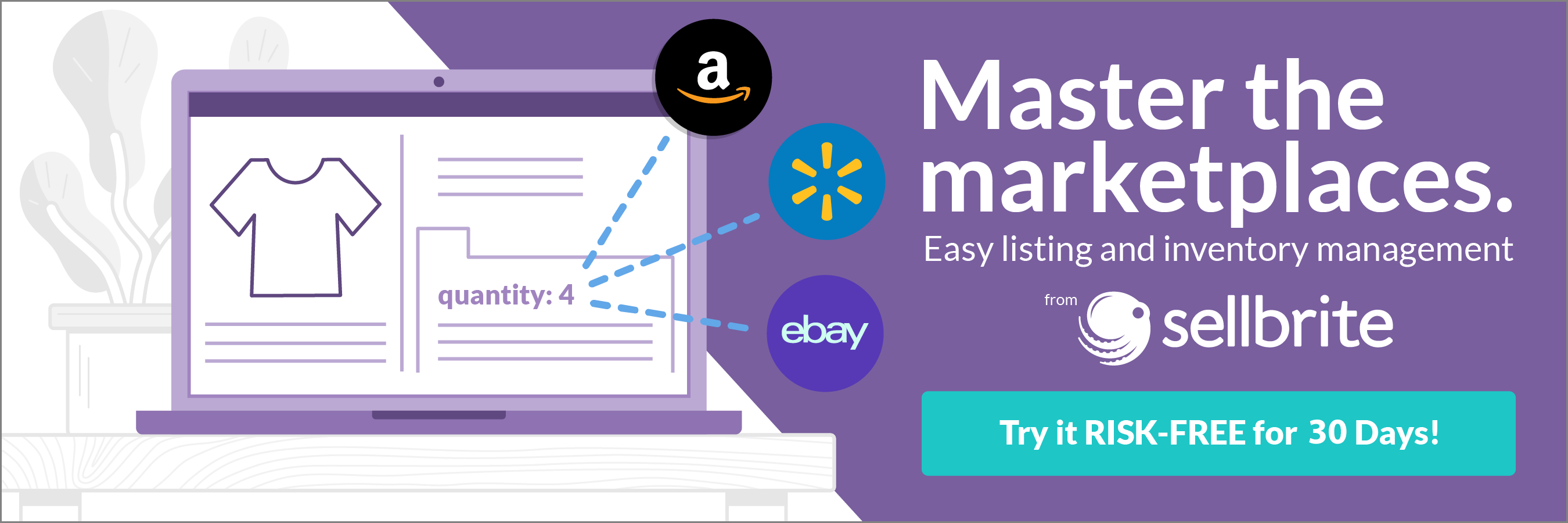Organizing inventory across multiple online retail channels isn’t easy, and those logistical challenges can slow down your ecommerce expansion. However, the right Shopify inventory management software can handle the more tedious aspects—no matter how large you grow.
Whether you have an ecommerce store on Shopify, are looking to expand your ecommerce store to Shopify, or just want to find more channels for your product, you need to upgrade your Shopify inventory management software to successfully grow your business.
Shopify’s Inventory Management is Good; Third-Party Software is Better
Shopify has a system for inventory management, but syncing that inventory across multiple listings is more than it can handle. Shopify knows this, of course, which is part of the genius of its design—any system you don’t like can be pulled out and replaced with a more comprehensive and specialized app from another developer.
Get the most out of your online inventory by adding third-party apps through Shopify, which is designed to integrate with third-party software and the most popular ecommerce channels.
Cleans Up Your Logistics
Shipping and inventory logistics stall mainly because of bad (or insufficient) data about what you’re selling, and when. Shopify inventory management software can do the following:
- Help calculate the frequency of products being ordered
- Prevent perishable goods from going bad
- Prevent dead stock from taking up warehouse space
- Prevent delays from supply/demand issues with popular products
All of these features can help an expanding ecommerce store save money and create a more efficient ordering/shipping chain.
Reduces Your Paperwork
Inventory management software for Shopify saves you time and a mess of paperwork, with the added benefit of protecting a rainforest or two from daily inventory tracking sheets. Instead, inventory management apps like Sellbrite for Shopify let you manage all of your inventory from the same digital location.
Your Shopify store will get your inventory data from an Excel master document your warehouse (or warehouses) manage. This Excel doc can be uploaded to your Shopify inventory management software as frequently as you like, at whatever time of day you choose.
The benefits over traditional paperwork are numerous. First, physical paperwork is only accessible in one location—an Excel doc on the cloud is available anywhere. Second, a digital doc can be more secure if it’s stored in an encrypted cloud, and all users permitted to access it must use two-factor authentication. Third, paperwork can be lost or damaged—digital goods backed up on a cloud server have multiple redundancies to prevent loss of data.
And, of course, you help the planet a little by doing your part to reduce some of the 21% share of greenhouse gases created by paper production alone.
Keeps Shipping Consistent
The best third-party Shopify inventory software gives you the option of keeping your own shipping schema no matter where you sell. You won’t be beholden to Amazon or Etsy’s rules or methods, and can keep your warehouse exactly as it is.
Inventory management software also lets you use the shipping data from your customer—region, local taxes, shipping laws—to make shipping simpler. Not only will the software calculate the shipping price and method no matter the region, but it will even print out your own custom shipping labels.

What to Look for in Your Inventory Management Software
A good inventory management app is customizable. It can be made to fit your business’s current workflow.
Businesses need inventory management software that’s capable of controlling logistics, that doesn’t require them to change their current online catalog, and that provides the option for individualizing inventory management to their business’s needs.
Inventory and Warehouse automation
The ideal inventory management software is more than just a shared spreadsheet or a shopping data aggregator. A good inventory app for Shopify will also have the ability to make moves without you, based on the parameters you set in advance.
If you have multiple warehouses, either your own or through a specific channel’s fulfillment center (or both), you don’t want to have to figure out the origin of every order and decide which warehouse to ship from yourself. The inventory management app you choose should be able to make those small decisions for you based on location and shipping speed.
Custom Inventory Rules
Shopify inventory management software should allow you to create special rules for your stock. No two stores—ecommerce, brick-and-mortar, or hybrid—are alike. No two products are alike. Your inventory management software needs to be granular enough to take that into account.
A store that sells perishables is going to have completely different rules for inventory management than one that sells hardware. A shop that sells electronics has to be aware of not overbuying stock: They may not “go bad” like a crate of apples, but they a) are expensive and b) can become obsolete or out-of-date pretty quickly.
Inventory management software (the kind worth installing, anyway) will allow you to give different products different rules. You can set limits on how long the inventory should stay in the warehouse before it spoils (or goes on sale), to lower values for how much to store at a time (for large items), or even to establish different parameters per warehouse.
A Simple Interface
One of the benefits of a Shopify-integrated inventory app is its central location and easy accessibility. These benefits disappear if the user interface is too complex.
The inventory app you use should be graphically focused, with drag-and-drop features. This isn’t just to feel nice or look pretty, but to make your inventory app usable on both desktops and mobile devices. Warehouses rely on mobile tablets more and more, and your inventory interface should reflect that.
Think bright colors, big buttons, the ability to grab an item or text field and drag it where you need it—these are all road signs toward a useful inventory interface.
How to Integrate 3rd Party Software with Shopify
Shopify’s inherent modularity makes app integration quick and easy, but we can help walk you through adding inventory management software to your ecommerce store.
First, head to the Shopify App Store and check out an inventory management software like Sellbrite. You’ll find plenty of other apps here worth checking out to level up your store, but for now, let’s focus on inventory management.
Second, click on “Add app” to add the software to your Shopify store. If you’re not logged into your Shopify account, it will log you in at this point.

Third, go to the admin section of your Shopify account and click on the “Apps” link in the left-hand toolbar.

Once in the App section of your admin portal, you’ll see a listing of all installed apps. You can check out their details, manage fees, uninstall apps, or open the app by clicking on it. This where you’re going to spend the majority of your time.
When you open your inventory management app, follow the app’s walkthrough to learn how to use and master it. You’ll return to this section of your Shopify admin portal whenever you want to use the app, so adding a bookmark is wise.
Start Selling Across Multiple Marketplaces
Shopify inventory management software helps you track listings, orders, shipping, and inventory across multiple retail channels. Apps like Sellbrite for Shopify do so by creating a central control panel in Shopify to serve as the hub of your ecommerce network.
Every change you make in your central Shopify store will trigger the same changes on Amazon, Google Shopping, Walmart, eBay, and Etsy. This also works in reverse. That means that all retail channels pull up-to-date information from your central hub.
Let’s say you have three products in stock, and you just got two orders from Amazon and one from Walmart. A fourth attempted order on Google Shopping will be stopped because it knows you’re out of inventory, thus preventing you from overselling your stock and potentially angering a potential customer.
Leverage a Big Marketplace’s Visibility but keep your shipping methods
The merits of expanding your ecommerce shop to a channel like Amazon are obvious—not only did Amazon pull in $280 billion net revenue last year, but the second-leading source of that revenue was from ecommerce retail listings.
There are two ways to go about managing your inventory with Amazon. The first is to use Amazon’s own FBA (Fulfilled by Amazon) warehouses to manage your stock. The second is to sync your Shopify with your Amazon listing and use your own warehouse and shipping.
There are benefits to both: Amazon’s shipping chain is obviously pretty successful. However, managing your own inventory does have its benefits. In the COVID-19 era, Amazon’s high demand has caused them to struggle with shipping delays.
If your product is listed on Amazon but fulfilled by your warehouse, your shipping can stay as agile as you need without being connected to such a massive operation.
Expand your store without a warehouse
Walmart has created its own fulfillment centers for third-party vendors, clearly taking aim at Amazon’s market share. Shopify inventory apps like Sellbrite allow you not only to list your products on Walmart, but to have them fulfill your orders as well.
Again, if you have a solid warehouse/shipping strategy, there’s no need, and you can simply list your products on Walmart’s (or Amazon’s) website. But having the ability to use their warehouses and shipping can help a smaller ecommerce shop expand without having to purchase real estate and employ a labor force.
And while Walmart may not have Amazon’s ecommerce clout, they finished third in 2019 and enjoyed a 37% increase in online sales. This is why multichannel selling is so important—you don’t have to choose. You can drop your listings on every marketplace out there and reap the rewards.
Don’t Let Logistics Be a Roadblock to Your Success
Even in a digital world, we’re beholden to supply and demand. The physical limitations of inventory and shipping will anchor any expanding business. Shopify inventory management software can dynamite through that logistical roadblock by syncing listings, inventory status, and shipping rules across any platform you choose to conquer.



